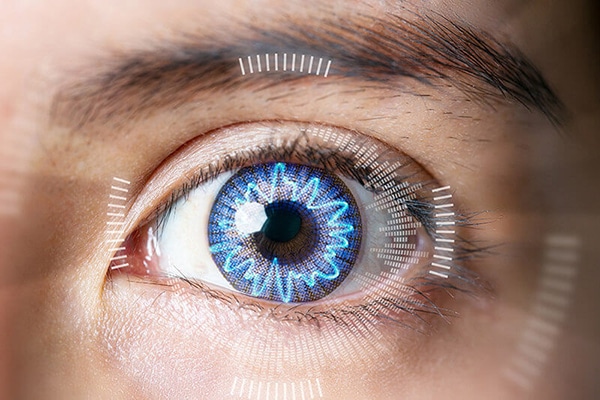Now Offering Free LASIK Consultations: Book Online Now!
Corneal Crosslinking
Corneal Cross-Linking in San Diego
Corneal crosslinking is a very promising treatment designed to stop the progression of keratoconus and avoid the need for more invasive treatment measures.
With this short, in-office procedure, the team at Eye Care of San Diego can strengthen a cornea weakened by keratoconus, preserve your precious vision and avoid corneal transplant surgery.

How Does Corneal Crosslinking Work?
The cornea is made up of millions of tiny fibers that are linked together to help the cornea retain its round shape. Diseases like keratoconus or post-LASIK ectasia can threaten the stability of these fibers, causing the cornea to lose its round shape and take on a more cone-like shape. As the shape of the cornea changes, it severely compromises visual clarity.
If you have developed keratoconus, you may try to compensate for reduced vision by wearing glasses or contact lenses. But if keratoconus progresses to a certain point, wearing contact lenses can become very uncomfortable or nearly impossible.
Nowadays, the team at Eye Care of San Diego offers corneal crosslinking to stop the progression of keratoconus.
Corneal crosslinking uses a combination of a riboflavin (B2) solution and controlled exposure to ultraviolet light to create new links between the collagen fibers within the cornea. This helps the cornea retain its round shape instead of bulging and distorting.
Although corneal crosslinking cannot reverse existing distortion of the cornea, it can prevent further changes from occurring. Ultimately, our doctors hope that corneal crosslinking can delay or prevent the need for more invasive treatments like corneal transplant, which require more downtime and have more risks.
Corneal Crosslinking, Step by Step
Corneal crosslinking can be performed in our office.
The procedure can be done with the epithelium (outermost layer of the cornea) “on” or “off.” In epithelium-off corneal crosslinking, the complete outer layer of the cornea is removed prior to administering the riboflavin and UV light. In epithelium-on corneal crosslinking, the outer layer is left untouched while treatment is performed. Our doctor can determine the approach that makes the most sense for your case.
Prior to treatment, you will undergo a routine eye exam and your corneal thickness will be measured. Your eyes will be completely numbed to prevent discomfort or pain during the procedure.
At the start of treatment, you will be placed in a reclining position. The epithelial layer of your cornea may or may not be removed. Riboflavin drops will be placed on your cornea over a period of 30 minutes; then, your eye will be exposed to a controlled amount of ultraviolet light for an additional 30 minutes.
After the treatment, a bandage contact lens will be placed in the eye. Your recovery time will vary, based on whether the epithelium was removed. In general, the recovery should be fairly short.
Depending on how much the disease has progressed, you may benefit from as little as a single appointment. In certain cases, corneal crosslinking is combined with the placement of small corneal inserts called Intacs to help reshape and stabilize the cornea.
Contact Our Cornea Specialists
To learn more about keratoconus treatment and corneal crosslinking, please contact Eye Care of San Diego today.








